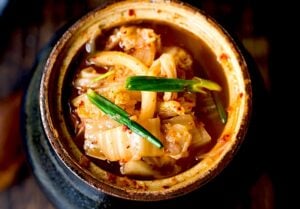Description
This easy Kimchi recipe is simple to make and takes only 30 minutes of hands-on time before Mother Nature takes over! Full of healthy, gut-healthy probiotics, this authentic kimchi is vegan-adaptable, gluten-free, and can be made as spicy or as mild as you like! Includes a video.
Ingredients
- 2 pounds napa cabbage, (large napa cabbage)
- 1/4 cup sea salt (60 grams)
- 2 cups daikon radish, cut into matchstick strips (optional, or use carrots)
- 1 bunch scallions, trimmed and cut into 1-inch pieces
- 1 tablespoon fresh ginger, sliced ( 2-3 disks, peels ok)
- 6 cloves garlic, whole
- 1 shallot, quartered (optional)
- 2–6 tablespoons Korean-style red pepper flakes (gochugaru) or sub gochujang – see notes!
- 2 tablespoons fish sauce (or use vegan fish sauce, shrimp paste, miso paste, or soy sauce), more to taste
- 2 teaspoons sugar ( or an alternative like honey, brown rice syrup)
- OPTIONAL:1 tablespoon glutenous rice powder (see notes)
Instructions
- SALT THE CABBAGE (6-8 hours): *Reserve 1-2 outer leaves of the napa cabbage and refrigerate for later use. Core and cut the remaining cabbage into 1-inch pieces and place in a large bowl with the salt and toss well. Add enough cool water to cover the cabbage and stir until salt is dissolved. Keep the cabbage submerged with a plate over the bowl and let this stand at room temperature 6-8 hours (giving a stir midway through if possible) or overnight.
- Drain the cabbage, saving the brine. Rinse the cabbage (not excessively, just a little quick rinse), drain, squeeze out any excess water, or blot with paper towels, and place it back in the bowl, adding the daikon radish and scallions.
- Make the PASTE: Place the ginger, garlic, shallot, red pepper flakes, fish sauce (or alternatives) and sugar in your food processor. Add optional rice powder (see notes!) Process until well combined, pulsing, until it becomes a thick paste.
- MASSAGE: Scoop the paste over the cabbage and using tongs or gloves, mix and massage the vegetables and the red pepper mixture together really well, until well coated.
- PACK the cabbage into a large, two-quart jar (or two, quart jars) or a crock, leaving 1-2 inches room at the top for juices to release. Add a little of the reserved brine to just cover the vegetables, pressing them down a bit ( so they are submerged) Place the whole cabbage leaf over top, pressing down- this should help keep the kimchi submerged under the brine. You can also use a fermentation weight placed over top of the whole leaf to keep it submerged. Or a small zip lock filled with water. Basically anything that touches air may mold – but no worries if this happens (see notes) it is not ruined.
- FERMENT (3-4 days) Cover loosely with a lid (allowing air to escape) and place the jar in a baking dish (or big bowl) to collect any juices that may escape. (The idea though, is to keep as much of the flavorful juice in the jar, so don’t overfill.) Leave this somewhere dark and cool (55F-65F is ideal) for 3 days. A basement or lower cooler cabinet in the pantry or kitchen away from appliances works best.
- EVENING OF DAY 3: Check for fermentation action or bubbles. Tap the jar and see if tiny bubbles rise to the top. Check for overflow (which also indicates fermentation). If you see bubbles, it is ready to store in the refrigerator where it will continue to ferment and develop more flavor slowly. For a softer tangier kimchi, you can continue to ferment for 3 more days or longer. If no action, give it another day or two. If you don’t see bubbles when tapping the jar, it just may need a couple more days- especially in cooler climates. Be patient. See the troubleshooting section below.
- REFRIGERATE: After you see bubbles (usually 3-5 days) the kimchi is ready, but it won’t achieve its full flavor and complexity, until about 2 weeks (in the fridge) slowly fermenting. The longer you ferment, the more complex and tangy the taste. If you like a fizzy brine, tighten the lid, burping every week or so. If you don’t want to think about it, give the lid one loose twist, so it’s on there, but gases can escape.
- Maintenance: This will keep for months on end in the fridge (as long as it is submerged in the brine) and will continue to ferment very slowly, getting more and more flavorful. Feel free to remove the cabbage leaf and just press kimchi down under the brine, after each use. ( See notes for adding more brine.)
- SERVE: Serve it as side dish: scoop it out using a slotted spoon, place in a small bowl, drizzle with sesame oil , toasted sesame seeds, and fresh scallions. Or Use it in Kimchi Fried Rice, Kimchi Burritos, Seoul Bowls, Kimchi Soup!
Notes
For milder kimchi, start with 2 tablespoons Korean chili flakes ( you can always stir in more). I like a spicy version with 6 tablespoons. 4 tablespoons is medium spicy.
If substituting with gochujang paste, add 2-6 tablespoons. You can always start conservatively and add more to taste after fermentation.
If you like your kimchi, thick, and less watery, you can use sweet glutenous rice powder to thicken. This is not the same as rice flour! Cook 1 tablespoon glutenous rice powder with ½ cup water, in a small pot over medium heat, stirring constantly until it boils. Let cool, still whisking occasionally. Add to the chili paste in the food processor. Continue with recipe.
BRINE If you need or want to add more salt brine to the kimchi, to keep it submerged, mix water and salt at this ratio: 1 cup water and 1 1/4 teaspoon fine sea salt. Stir it together first, pour over the kimchi.
TROUBLESHOOTING:
- MOLD If your cabbage leaf that is holding the kimchi down, happens to mold, just remove it, wipe out the rim of the jar as best you can, and replace it with a fresh one. Basically, if cabbage touches air here, it will mold, so after each use, press the kimchi down under the brine.
- NO BUBBLES: Check the temp of the kimchi using a kitchen thermometer. Ideally, you want this between 50-70F. 60-65 is best.
Nutrition
- Serving Size: ¼ cup
- Calories: 20
- Sugar: 1.6 g
- Sodium: 822.5 mg
- Fat: 0.2 g
- Saturated Fat: 0 g
- Carbohydrates: 3.9 g
- Fiber: 0.4 g
- Protein: 1.3 g
- Cholesterol: 0 mg

